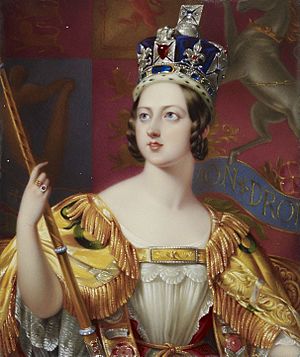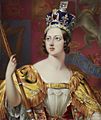His Majesty's Government (term) facts for kids
The phrase His Majesty's Government is a special name for the government in countries that still have a king or queen as their head of state. When a queen rules, it's called Her Majesty's Government. This term is used in countries known as Commonwealth realms, like Canada, Australia, and the United Kingdom. It shows that the government serves the King or Queen. This way of naming governments started a long time ago during the British Empire. Many countries that were once part of the British Empire still use this term today.
Some Commonwealth countries, like Malta, no longer have a monarch. In these places, the term "His Majesty's Government" is not used anymore, except when talking about history.
Contents
How the Name Changed Over Time
In the past, during the British Empire, the name His (or Her) Majesty's Government only referred to the main government in London, England. As the Empire grew, more places gained the right to govern themselves. This meant the name needed to be clearer.
Governments in the Empire
Countries like Canada and Australia became "Dominions." This meant they were still part of the Empire but had more independence. To show this, people started saying things like "the Crown in right of Canada." This meant the King or Queen was acting as the monarch of Canada, not just the UK.
Sometimes, the interests of different parts of the Empire were not the same. For example, in 1893, Canada and the United States had a disagreement about fishing in the Bering Sea. Even though Canada's interests were different from the UK's, the UK government handled Canada's foreign relations.
Becoming Independent Nations
After the Statute of Westminster 1931, Dominions became equal partners with the United Kingdom. This led to the Empire changing into the Commonwealth of Nations. Because of these changes, the phrase His Majesty's Government in… started to be used. This helped show the difference between independent governments. For example, people would say His Majesty's Government in the Irish Free State.
Later, the way former Dominions referred to their governments changed again. It became similar to how the UK government was named. For instance, it became His Majesty's Australian Government. Other smaller governments, like those in colonies or provinces, usually just used Government of [region/territory].
Why the Monarch's Name is Used
The term "His/Her Majesty's Government" is used to show that the government belongs to the King or Queen. It does not belong to the cabinet (the group of top ministers) or the prime minister. Even though the monarch doesn't usually make daily decisions, the government officially serves them.
Naming Governments After Prime Ministers
Even though the official name is "His Majesty's Government," people often refer to governments by the name of the prime minister. For example, when Margaret Thatcher was Prime Minister of the United Kingdom from 1979 to 1990, her government was often called the "Thatcher Government." In Canada, the government led by Stephen Harper from 2006 to 2015 was known as the "Harper Government."
It is more correct to call these periods of government "Ministries." For example, the time when David Cameron was British Prime Minister (2010-2016) is known as the Cameron Ministries.
The Monarch's Role in Choosing Ministers
In the past, the King or Queen had a lot of power to choose their own ministers. For example, during the reign of George III of the United Kingdom, the monarch had almost complete control over who was in the government. This meant the government truly belonged to the monarch.
Over time, the power of the monarch in government slowly decreased. Queen Victoria was one of the last monarchs who tried to choose who would be in her government. For example, she disliked William Ewart Gladstone, which helped Lord Salisbury stay in power. Even back then, some people thought her actions were not quite right for a monarch.
Today, the monarch formally appoints ministers. However, in reality, the head of state usually has no choice in who becomes a minister, except sometimes the Prime Minister. This only happens in special situations, like when no single party wins enough seats in an election.
As the monarch's direct role in running the government has become smaller, the term "His/Her Majesty's Government" is used more formally. It is less common in everyday talk. This is because the power of the Prime Minister has grown a lot. The Prime Minister is now the main leader of the government.
For example, if someone wanted to talk about the British government's policy on railways in 1996, it would not be very helpful to say "Her Majesty's Government." This is because Queen Elizabeth II had no part in making that policy. It would be more helpful to say the "Major Government," because Prime Minister John Major was in charge of that policy.
Different Ways to Use the Term
The idea of the monarch's ownership can also apply to individual government departments or officials. For example, His Majesty's Railway Inspectorate is the group that checks train safety in Britain. Also, when John Howard was Prime Minister of Australia, he was sometimes called Her Majesty's Prime Minister for the Commonwealth of Australia.
This idea can be made even more specific. It can show which part of the the Crown the monarch is acting for. For example, when British passports are issued, they say: "His Britannic Majesty's Secretary of State Requests and requires in the Name of His Majesty..." This means the request is from the British Home Secretary, not the whole British Government. It is also only in the name of the British King, not as King of any other country.
Images for kids
See also
- Loyal opposition



